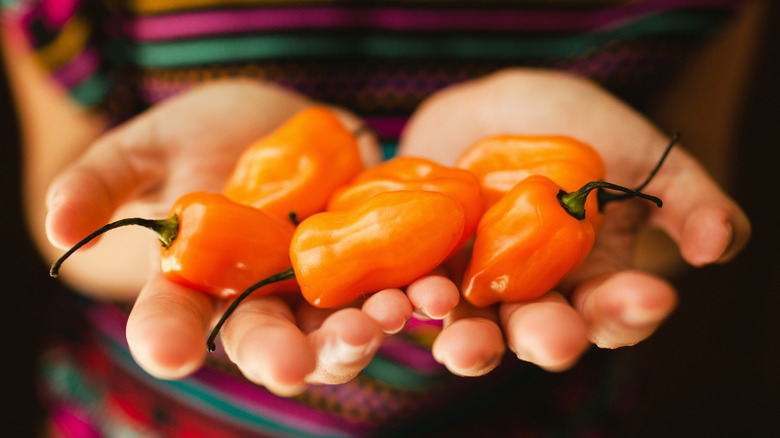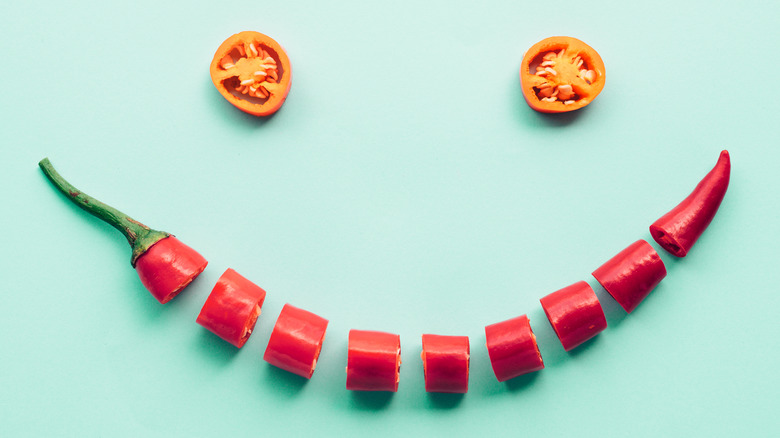What Is The Difference Between A Habanero And Jalapeño Pepper?
If you like spicy food, you're definitely aware that hot peppers possess a huge range of heat and flavor variability. They can give your tongue a little tingle, or make your adrenaline pump and your eyelids sweat. Two popular peppers are the habanero (Capsicum chinense) and the jalapeño (Capsicum annumm), both of which are used to add excitement to dishes and sauces from multiple types of cuisine.
Cayenne Diane explains that peppers are structurally similar to tomatoes, persimmons, and grapes, in that they contain many seeds within each individual structure. Perhaps surprisingly, this distinction classifies habaneros and jalapeños not only as fruit, but more specifically as berries.
Multiple characteristics distinguish a habanero from a jalapeño, but the most obvious difference is in their appearance. There are many varieties and colors of habanero, but the most common type are bright orange, have smooth skin but a rotund, slightly wrinkled shape, and average about 2 inches in length (via Pepperscale). Fresh jalapeños are usually deep green and relatively cylindrical with tapered ends, measuring around three inches in length (also via Pepperscale).
Which pepper is hotter?
One burning question you probably have is related to the spiciness of a habanero versus a jalapeño. Which one is more likely to send you into a haze of slightly painful bliss? It might shock you to know that, in the grand scheme of peppers, jalapeños aren't considered super hot.
Pepperscale says a habanero is much more likely than a jalapeño to have you guzzling ice water or milk after you eat one. Up to 140 times more likely, according to the Scoville heat scale. This universal standard for measuring pepper heat ranks habaneros between 100,000 and 350,000 "heat units" (via Pepperscale), whereas jalapeños only range between 2,500 to 8,000.
Chile Pepper Madness uses the term "gateway" to describe crisp jalapeños, indicating that non-pepper eaters can slowly acclimate themselves to a brave new world of spice without totally searing their taste buds before they're ready.
Why is there such a wide range of heat within individual pepper types? Balcony Garden Web says that environmental stresses can increase the amount of capsaicin produced in a pepper plant as it is growing, which affects how hot the fruit will be.
What does each taste like?
Habanero and jalapeño peppers have distinctly different flavor profiles. Bon Appétit uses the adjective "floral" to describe habanero, and Pepperscale says they have a complex taste with notes of fruit, a touch of sweetness, and smoky undertones, a blend which combines particularly well with tropical fruits to create sauces and salsas with a sweet/fiery chili kick. Bon Appétit suggests that if you love the taste of habanero but find their stinging heat to be unbearable, soaking a handful of the peppers in tequila or vodka for a bit yields a lovely infused liquor, but also cuts their killer spice so you can use them for cooking.
Fresh jalapeños have a similar flavor to a crisp green bell pepper, just markedly warmer. The Spruce Eats explains that they're usually picked prior to fully ripening and their vibrant green color is echoed in their slightly bitter, "grassy" taste. They turn red as they mature. Because jalapeños are a comparably mild pepper, they can be used to enhance food in a myriad of ways without overpowering the dish. Diced jalapeños round out salsa and guacamole beautifully. When sliced, jalapeños make a tasty additive to entrees, or they can be grilled and eaten whole (via The Spruce Eats).
They have similar health benefits
Both habaneros and jalapeños are jam-packed with flavor and lots of health benefits, says Healthline. These tiny fruits are virtually fat- and calorie-free, and extremely high in fiber. Vitamin C and vitamin B6 are two other big players in their chemical makeup.
The capsaicin in hot peppers has been shown to enhance metabolism and decrease appetite, potentially causing your body to burn fat more quickly and efficiently. It also promotes vascular health.
Capsaicin can also affect your nervous system in an interesting way. Business Insider describes how eating a hot pepper quickly creates a pronounced physical reaction that ultimately affects your mood: capsaicin attaches itself to pain receptors, which alerts your body to a potential threat. Your brain wants to alleviate the perceived discomfort, so it sends out a flood of feel-good chemicals that give you a sense of breathless exhilaration.
If you can stand the heat, peppers like habanero and jalapeño will keep you happy in — and out of — the kitchen.



